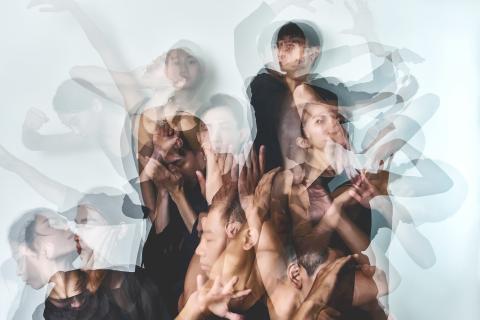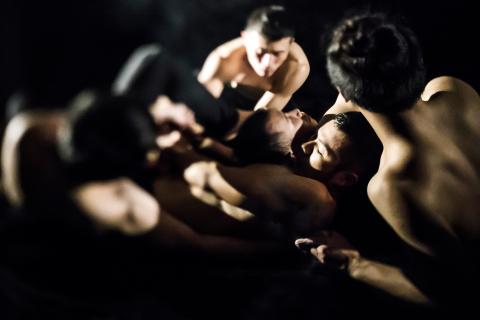Choreographer and T.T.C. Dance (張婷婷獨立製作) founder Chang Ting-ting (張婷婷) died of cancer on Jan. 31, but her company is continuing under new artistic director Doris Chiang (江毓瑄).
Chiang, like Chang, graduated from the National Taiwan University of Arts’ (國立臺灣藝術大學) dance department.
Initially the company was going to just fulfill its international commitments made by Chang for this year, but the decision was made to keep it going under Chiang.

Photo courtesy of T.T.C. Dance
This weekend it is presenting a new production that Chang had the idea for, but is being executed by Chiang and Malaysian composer and sound designer Ng Chor Guan (黃楚原).
Twin City Chronicle: Taipei X Penang (雙城紀事:臺北X檳城) was envisioned by Chang as the first in a series of productions exploring the complex interrelations of life, cities and globalization. Her aim was to explore the artists’ memories and the aspirations of their own cities, and how it continues to shape and transform their art.
The company said the new work is about seeing the two cities and seeing life.

Photo courtesy of Bulareyaung Dance Company
Ng, the cofounder and artistic director of Selangor-based Toccata Studio, is well-known on the international arts festival circuit. He had worked with T.T.C. Dance before, on Project 2020, a 2016 production with Malaysia’s ASK Dance, a Hong Kong lighting designer and 17 volunteer performers. He has also collaborated with Mobius Strip Theatre (莫比斯圓環創作公社).
Ng said he became good friends with Chang when they worked together three years ago, and he knew she had envisioned the Twin City Chronicle series a long time ago.
“I believe that you will see a lot of new creative elements, but you can also appreciate the original intention of Tingting’s original creation,” he said in the company’s news release.
Ng is known for using a theremin, an electronic instrument that is played by its user without physical contact, by means of antennas that sense the position of the user’s hands.
He said he uses the theremin not just to create soundtracks but to construct visual and auditory experiences, and the sounds he has created for this latest production mix Malaysian elements with Western electronic ones.
Twin City Chronicle: Taipei X Penang premieres tomorrow night at the National Experimental Theater in Taipei, which was also the venue for Chang’s last work, Deja vu (既視感), which opened on Nov. 30 last year.
It turns out that 2016 was crucial as well for another small Taiwanese dance troupe, Bulareyaung Dance Company (BDC, 布拉瑞揚舞團).
That was the year the troupe debuted two works, Qaciljay (阿棲睞) in May at the National Theater in Taipei as part of the theater’s “1+1 Dance Series” in a double-bill with Ku Ming-shen’s (古名伸) Sadhu (沙度), and then Colors (漂亮漂亮) in October at the Cloud Gate Theater in New Taipei City’s Tamsui District (淡水).
A long-standing complaint of mine is that smaller Taiwanese companies rarely have the financial means to keep their works in repertoire, which results in audiences having limited chances to see a show: A production debuts, perhaps does a limited tour, and then disappears.
So it is great that BDC has been able to tour a double-bill show this year, Qaciljay × Colors, which will be at the New Taipei City Xinzhuang Culture and Arts Center on Saturday night.
Qaciljay, which means rock in the Paiwan language, is about the pressures of history and traditional culture — and why indigenous people sing when walking in the mountains.
Colors is about life on the east coast, the sea and Aboriginal youth, told through a series of vignettes.
While Colors is not as emotionally powerful as Qaciljay or many of Bula’s other works, it is terrific fun, just like a day on the beach with friends, and the chance to see both these works is worth the trudge from Taipei to Sinjhuang District (新莊).

May 11 to May 18 The original Taichung Railway Station was long thought to have been completely razed. Opening on May 15, 1905, the one-story wooden structure soon outgrew its purpose and was replaced in 1917 by a grandiose, Western-style station. During construction on the third-generation station in 2017, workers discovered the service pit for the original station’s locomotive depot. A year later, a small wooden building on site was determined by historians to be the first stationmaster’s office, built around 1908. With these findings, the Taichung Railway Station Cultural Park now boasts that it has

The latest Formosa poll released at the end of last month shows confidence in President William Lai (賴清德) plunged 8.1 percent, while satisfaction with the Lai administration fared worse with a drop of 8.5 percent. Those lacking confidence in Lai jumped by 6 percent and dissatisfaction in his administration spiked up 6.7 percent. Confidence in Lai is still strong at 48.6 percent, compared to 43 percent lacking confidence — but this is his worst result overall since he took office. For the first time, dissatisfaction with his administration surpassed satisfaction, 47.3 to 47.1 percent. Though statistically a tie, for most

Wooden houses wedged between concrete, crumbling brick facades with roofs gaping to the sky, and tiled art deco buildings down narrow alleyways: Taichung Central District’s (中區) aging architecture reveals both the allure and reality of the old downtown. From Indigenous settlement to capital under Qing Dynasty rule through to Japanese colonization, Taichung’s Central District holds a long and layered history. The bygone beauty of its streets once earned it the nickname “Little Kyoto.” Since the late eighties, however, the shifting of economic and government centers westward signaled a gradual decline in the area’s evolving fortunes. With the regeneration of the once

In February of this year the Taipei Times reported on the visit of Lienchiang County Commissioner Wang Chung-ming (王忠銘) of the Chinese Nationalist Party (KMT) and a delegation to a lantern festival in Fuzhou’s Mawei District in Fujian Province. “Today, Mawei and Matsu jointly marked the lantern festival,” Wang was quoted as saying, adding that both sides “being of one people,” is a cause for joy. Wang was passing around a common claim of officials of the People’s Republic of China (PRC) and the PRC’s allies and supporters in Taiwan — KMT and the Taiwan People’s Party — and elsewhere: Taiwan and